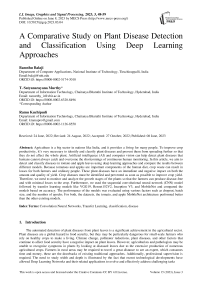A Comparative Study on Plant Disease Detection and Classification Using Deep Learning Approaches
Автор: Banothu Balaji, T. Satyanarayana Murthy, Ramu Kuchipudi
Журнал: International Journal of Image, Graphics and Signal Processing @ijigsp
Статья в выпуске: 3 vol.15, 2023 года.
Бесплатный доступ
Agriculture is a big sector in nations like India, and it provides a living for many people. To improve crop productivity, it’s very necessary to identify and classify plant diseases and prevent them from spreading further so that they do not affect the whole plant. Artificial intelligence (AI) and computer vision can help detect plant diseases that humans cannot always catch and overcome the shortcomings of continuous human monitoring. In this article, we aim to detect and classify diseases in tomato and apple leaves using deep learning approaches and compare the results between different models. Because tomatoes and apples are important components of the human diet, crop waste can result in losses for both farmers and ordinary people. These plant diseases have an immediate and negative impact on both the amount and quality of yield. Crop diseases must be identified and prevented as soon as possible to improve crop yield. Therefore, we need to monitor and analyze the growth stages of the plants so that the farmers can produce disease-free and with minimal losses to the crop. Furthermore, we used the sequential convolutional neural network (CNN) model followed by transfer learning models like VGG19, Resnet152V2, Inception V3, and MobileNet and compared the models based on accuracy. The performance of the models was evaluated using various factors such as dropout, batch size, and the number of epochs. For both, the datasets, the tomato, and apple MobileNet architecture performed better than the other existing models.
Convolution Neural Networks, Transfer Learning, classification, disease
Короткий адрес: https://sciup.org/15018761
IDR: 15018761 | DOI: 10.5815/ijigsp.2023.03.04
Список литературы A Comparative Study on Plant Disease Detection and Classification Using Deep Learning Approaches
- Hassan, S. M., Maji, A. K., Jasiński, M., Leonowicz, Z., & Jasińska, E. (2021, June 9). Identification of plant-leaf diseases using CNN and Transfer-Learning Approach. MDPI. Retrieved April 25, 2022, from https://www.mdpi.com/2079-9292/10/12/1388.
- Qi, H., Liang, Y., Ding, Q., & Zou, J. (2021, February 23). Automatic identification of peanut-leaf diseases based on Stack Ensemble. MDPI. Retrieved April 25, 2022, from https://www.mdpi.com/2076-3417/11/4/1950.
- Trivedi, N. K., Gautam, V., Anand, A., Aljahdali, H. M., Villar, S. G., Anand, D., Goyal, N., & Kadry, S. (2021, November 30). Early detection and classification of tomato leaf disease using high-performance deep neural network. MDPI. Retrieved April 25, 2022, from https://www.mdpi.com/1424-8220/21/23/7987/htm.
- G. Geetha et al 2020, Plant Leaf Disease Classification and Detection System Using Machine Learning, https://iopscience.iop.org/article/10.1088/1742-6596/1712/1/012012.
- Parekh, M. (2019, July 16). A brief guide to Convolutional Neural Network(CNN). Medium. Retrieved April 25, 2022, from https://medium.com/nybles/a-brief-guide-to-convolutional-neural-network-cnn-642f47e88ed4.
- Christian Szegedy, Vincent Vanhoucke, Sergey Ioffe, Jon Shlens, Zbigniew Wojna, Rethinking the Inception Architecture for Computer Vision, Proceedings of the IEEE conference on computer vision and pattern recognition, pages: 2818-2826,2016.
- Szegedy, C., Ioffe, S., Vanhoucke, V., & Alemi, A. (2017). Inception-v4, Inception-ResNet and the Impact of Residual Connections on Learning. Proceedings of the AAAI Conference on Artificial Intelligence, 31(1). https://doi.org/10.1609/aaai.v31i1.11231.
- Karen Simonyan and Andrew Zisserman, Very Deep Convolutional Networks for Large-Scale Image Recognition, International Conference on Learning Representations,2015.
- L. Sifre. Rigid motion scattering for image classification. PhD thesis, Ph. D. thesis, 2014.
- Teki, Satyanarayana murthy., Varma, M.K., Harsha. (2021). Brain tumour segmentation using U-net based adversarial networks. Traitement du Signal, IIETA Publisher, Vol. 36, No. 4, pp. 353-359. https://doi.org/10.18280/ts.360408 .
- T.Satyanarayana Murthy, N.P.Gopalan, Sasidhar Gunturu, " A Novel Optimization based Algorithm to Hide Sensitive Item-sets through Sanitization Approach", International Journal of Modern Education and Computer Science (IJMECS), Vol.10, No.10, pp. 48- 55, 2018.DOI: 10.5815/ijmecs.2018.10.06.SCOPUS INDEXED
- T.Satyanarayana Murthy, N.P.Gopalan, Datta Sai Krishna Alla, "The Power of Anonymization and Sensitive Knowledge Hiding Using Sanitization Approach", International Journal of Modern Education and Computer Science (IJMECS), Vol.10, No.9, pp. 26-32, 2018.DOI: 10.5815/ijmecs.2018.09.04.SCOPUS INDEXED
- T.Satyanarayana Murthy, N.P.Gopalan, “A Novel Algorithm for Association Rule Hiding", International Journal of Information Engineering and Electronic Business (IJIEEB), Vol.10, No.3, pp. 45-50, 2018. DOI: 10.5815/ijieeb.2018.03.06
- Jidesh, P., and B. Balaji. 2018. “Adaptive Non-local Level-set Model for Despeckling and Deblurring of Synthetic Aperture Radar Imagery.” International Journal of Remote Sensing 39 (20): 6540–6556.
- Teki, S.M., Banothu, B., Varma, M.K. (2019). An un-realized algorithm for effective privacy preservation using classification and regression trees. Revue d'Intelligence Artificielle, 33(4): 313-319


